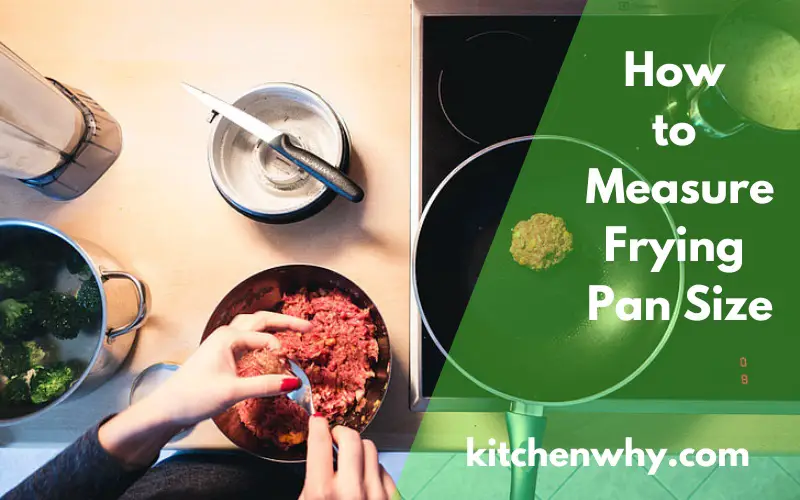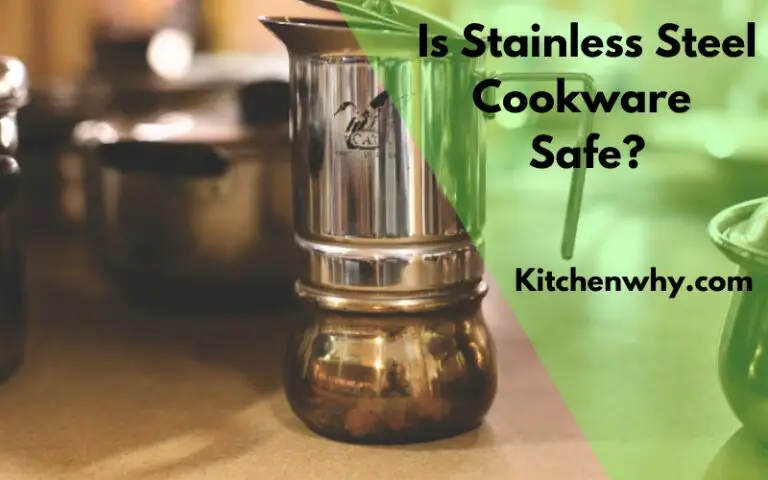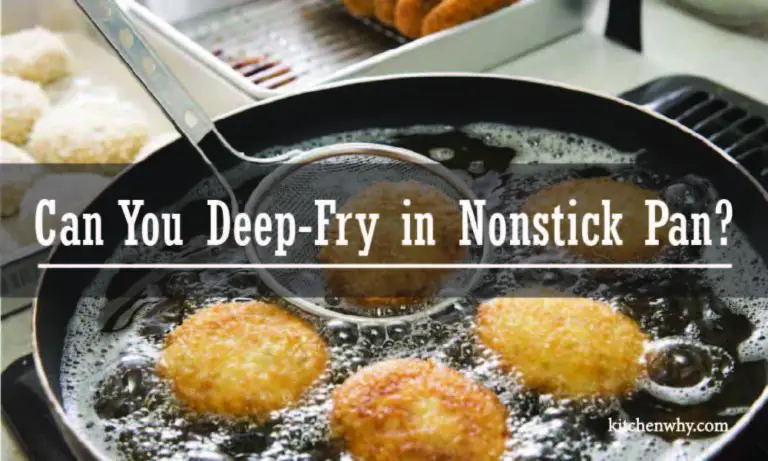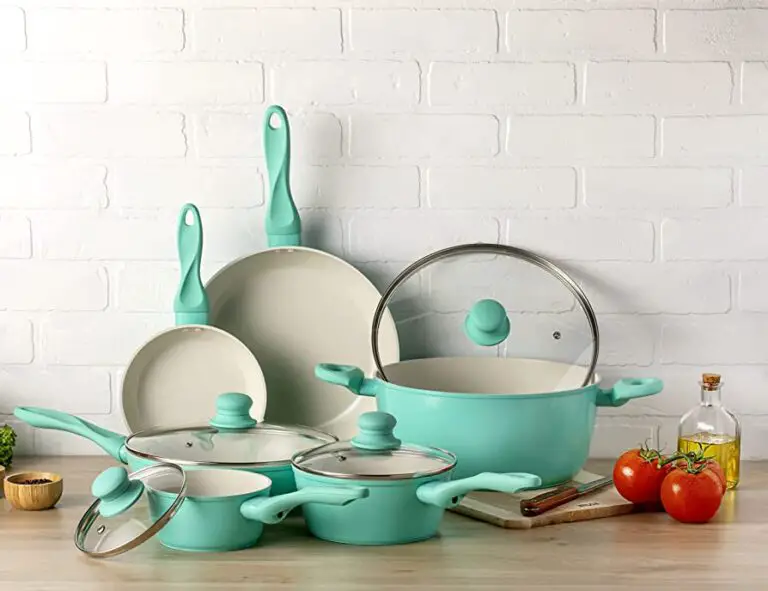How to Measure Frying Pan Size: Ultimate Guide

To measure the frying pan size, simply measure the diameter or width of the pan. If you’re wondering how to determine the size of your frying pan, it’s as simple as measuring its diameter or width.
This essential step allows you to identify the appropriate size for recipes and makes it easier to purchase replacement lids or accessories. Whether you’re a beginner or a seasoned cook, understanding the size of your frying pan ensures optimal cooking results and prevents any guesswork when following recipes.
In this article, we’ll explore various methods of how to measure your frying pan size, providing you with the knowledge you need to easily determine the dimensions of your pan. Along with the basic measuring techniques, we’ll also share some helpful tips and considerations. So let’s get started and take the guesswork out of measuring frying pan sizes.
How to Accurately Measure Frying Pan Size?
To accurately measure the size of a frying pan, you will need a measuring tape or a ruler. Follow these steps:
- Diameter Measurement: a. Gather the necessary tools:
- Measuring tape or ruler: Choose a flexible measuring tape or a ruler with clear markings in inches or centimeters.
- Ensure that the pan is clean and dry. Place the frying pan on a stable, flat surface with the bottom facing up.
- Position the measuring tape or ruler across the center of the frying pan.
- Extend the tape or ruler from one end of the pan’s rim to the opposite end, passing through the center.
- Make sure the measuring tape or ruler is straight and level.
- Read the measurement where the tape or ruler intersects the opposite end of the pan’s rim.
- Note down the measurement in inches or centimeters.
- Volume Measurement: a. Gather the necessary tools:
- Measuring cup: Use a liquid measuring cup with clear markings in liters or fluid ounces.
- Ensure that the pan is clean and dry. Place the pan on a flat surface.
- Decide on the volume level you want to measure, such as half the pan’s capacity or a specific volume.
- Fill the frying pan with water up to the desired level.
- Avoid overfilling the pan to prevent spillage.
- Pour the water from the pan into the measuring cup.
- Read the volume measurement on the measuring cup.
- Note down the measurement in liters or fluid ounces.
Understanding The Importance Of Accurate Measurement
When it comes to cooking, using the right tools and techniques is crucial to achieve the best results. This especially holds true when it comes to using the proper size frying pan. Many people underestimate the significance of accurate measurement in the kitchen, but it can greatly impact the outcome of your dishes.
Let’s dive deeper into why accurate measurement is essential and the potential consequences of using the wrong-sized frying pan.
Why Accurate Measurement Is Essential In The Kitchen
Accurate measurement plays a vital role in cooking, and here’s why:
- Even heat distribution: The right-sized frying pan ensures even heat distribution across the entire cooking surface. This helps in cooking the food evenly, preventing overcooked or undercooked spots.
- Cooking time: When using a pan that is too large or too small for the amount of food you are cooking, it can significantly affect the cooking time. A smaller pan may overcrowd the food, leading to longer cooking times, while a larger pan may result in faster cooking and potential food burn.
- Proper cooking techniques: Different dishes require specific techniques, such as sautéing, searing, or frying. Using the right-sized pan allows you to employ these techniques effectively, resulting in desirable texture and flavor.
- Efficiency and energy consumption: Using a pan that matches the quantity of food being cooked reduces energy wastage and increases cooking efficiency. A smaller pan may require excessive heat to cook the food, while a larger pan could lead to unnecessary energy usage.
The Impact Of Using The Wrong-Sized Frying Pan
Using the wrong-sized frying pan can have several negative consequences, including:
- Uneven cooking: When the pan is too small for the food being cooked, it may lead to overcrowding, causing uneven cooking. This results in some pieces being overcooked while others remain undercooked.
- Food texture and appearance: Improper pan size can affect the texture and appearance of your dishes. Overcrowding in a small pan can make food soggy or prevent it from achieving a desirable crispy exterior.
- Burnt or undercooked food: Inappropriate pan size can cause the food to burn or remain undercooked. With a small pan, the overcrowded food may not cook properly, and with a large pan, lack of proper heat distribution can lead to burnt areas.
- Wasted ingredients: Using the wrong-sized pan can lead to inefficient use of ingredients. Overcrowding the pan may limit the cooking space, preventing the ingredients from receiving adequate heat, resulting in food wastage.
Accurate measurement is crucial in the kitchen to ensure even cooking, proper cooking techniques, efficiency, and desired outcomes. Avoid the pitfalls of using the wrong-sized frying pan and elevate your culinary skills by using the appropriate pan size for your recipes.
Measuring The Diameter Of Your Frying Pan
Curious to know how big your frying pan is? Whether you’re planning to cook a specific recipe or looking to replace your pan, measuring its diameter is the key. Don’t worry, it’s a simple task that you can easily accomplish with a few basic tools.
In this section, we’ll walk you through a step-by-step guide on measuring the diameter of your frying pan and provide you with the necessary tools for precise measurements. So, let’s get started!
Step-By-Step Guide On Measuring The Diameter:
- Place your frying pan on a flat surface: Find a sturdy table or countertop where you can place your pan. Make sure the surface is stable to ensure accurate measurements.
- Take out a ruler or measuring tape: You’ll need a ruler or measuring tape to measure the diameter of your frying pan. A ruler with both inches and centimeters is ideal for precise measurements.
- Locate the center of the pan: Identify the center by visually dividing the pan into halves and finding where the halves meet. This is where you will measure the diameter.
- Align the ruler or measuring tape: Place the ruler or measuring tape across the center of the pan, ensuring that it spans from one end to the other.
- Read the measurement: Look at the ruler or measuring tape closely and note the measurement indicated at the edge of the pan. This number represents the diameter of your frying pan.
- Convert measurements if necessary: If your ruler or measuring tape provides measurements in both inches and centimeters, make note of both for your reference. You can always convert between the two measurements using a conversion chart or an online tool.
- Record the diameter: Once you’ve obtained the measurement, write it down for future reference. Knowing the size of your frying pan will come in handy when cooking specific recipes or searching for a replacement.
Tools You’ll Need For Precise Measurements:
- Ruler or measuring tape: Used to measure the diameter of your frying pan accurately.
- Flat surface: Provides a stable base for placing your pan and ensures reliable measurements.
By following this step-by-step guide and using the right tools, you can easily measure the diameter of your frying pan. Knowing the size of your pan will help you navigate recipes and make informed decisions when purchasing a new one.
So, grab your ruler or measuring tape, find a flat surface, and let’s get those measurements!
Determining The Depth Of Your Frying Pan
The depth of your frying pan plays a crucial role in determining what you can cook and how you can cook it. Whether you’re sautéing vegetables, searing a steak, or making a batch of stir-fry, having the right depth is essential for even heat distribution and proper food preparation.
In this section, we will explore why measuring the depth is important and provide techniques for accurately determining the depth of your frying pan.
Why Measuring The Depth Is Important:
- Cooking efficiency: The proper depth of your frying pan allows for better heat transfer, ensuring that your food cooks evenly. Incorrect pan depth can lead to uneven cooking, with some parts of your food being overcooked while others remain undercooked.
- Portion control: The depth of your frying pan determines how much food you can cook at once. If you’re cooking for a large family or hosting a dinner party, having a deeper pan allows you to prepare larger portions in a single batch.
- Recipe adaptability: Many recipes specify the pan depth required for optimal results. By knowing the depth of your frying pan, you can easily adapt recipes to suit your cooking equipment without compromising on taste or texture.
Techniques For Accurately Measuring The Pan Depth:
- Use a measuring tape: Measure the interior depth of your frying pan from the base to the rim. Keep the measuring tape straight for accurate results.
- Fill with water: Fill your frying pan with water until it reaches a certain depth. Use a measuring cup to determine the volume of water required. By measuring the amount of water used, you can determine the depth of your pan.
- Compare with standard measurements: Check the manufacturer’s specifications or product description to see if the frying pan depth is mentioned. This information can be useful for determining the depth without any further measurements.
- Stack-compatible cookware: If you have a set of cookware where the pots and pans are designed to stack together, you can compare the depth by stacking pans of known depths and observing how they align.
- Measure ingredients: Alternatively, you can use the depth of ingredients as a reference point. For example, if you have a recipe that requires a certain depth of oil or other liquids, you can measure the depth of the ingredient in your frying pan to ensure accuracy.
Determining the depth of your frying pan is a simple yet crucial step in achieving culinary success. By following these techniques, you can accurately measure the depth of your pan and enhance your cooking experience. So go ahead, grab your measuring tape or stack your cookware, and unlock the potential of your frying pan’s depth!
Calculating The Capacity Of Your Frying Pan
The Significance Of Knowing The Pan’S Capacity
Knowing the capacity of your frying pan is essential for efficient cooking and recipe preparation. Understanding how much food the pan can hold helps you determine portion sizes, plan your meals, and prevent overcrowding. Additionally, knowing the pan’s capacity ensures that you can achieve the desired cooking results by properly distributing heat and allowing for adequate airflow.
Calculating the pan’s capacity accurately is crucial to avoid culinary mishaps and achieve culinary success. In the following sections, we will explore various methods to calculate the pan’s capacity effectively.
Methods To Calculate The Pan’S Capacity Accurately
To measure the capacity of your frying pan accurately, consider implementing the following methods:
- Water test: Fill the pan with water, ensuring not to exceed the maximum fill line, if present. Measure the volume of water required to fill the pan completely. This measurement corresponds to the pan’s capacity.
- Weight approach: Weigh the pan before and after filling it with a known quantity of liquid, such as water or oil. The difference in weight reflects the weight of the liquid, which can be used to determine the pan’s capacity.
- Markings or indicator lines: Some frying pans come with markings or indicator lines on the interior, indicating various capacity levels. By referring to these markings, you can easily determine the pan’s capacity without the need for additional calculations.
- Volume formulas: If your frying pan has standard measurements, you can use volume formulas to calculate its capacity. For example, if the pan has a cylindrical shape, you can use the formula for the volume of a cylinder (v = π r^2 h) by measuring the radius (r) and height (h) of the pan.
- Manufacturer’s specifications: Consult the manufacturer’s specifications or product information for the frying pan to determine its capacity. They often provide this information to assist consumers in making informed purchasing decisions.
Remember that accurately measuring the frying pan’s capacity allows you to adjust recipes, avoid overcrowding, and achieve optimal cooking results. With these methods at your disposal, you can confidently measure your frying pan’s capacity and embark on culinary adventures with precision.
Considering The Handle Length And Weight Distribution
Frying pans come in various sizes, and choosing the right size for your needs is essential to ensure optimum cooking results. When measuring frying pan size, it’s not just about the diameter of the cooking surface. Another crucial factor to consider is the handle length and weight distribution.
Understanding the impact of these two aspects will help you make an informed decision when selecting the perfect frying pan for your kitchen. So let’s dive in and explore how handle length affects the overall size and the significance of weight distribution in cooking.
How The Handle Length Affects The Overall Size
- A longer handle adds to the overall length of the frying pan, making it appear larger.
- It influences the balance and maneuverability of the pan during cooking.
- Consider the storage space required for a pan with a longer handle.
- A shorter handle might be more suitable if you have limited storage space.
- A detachable handle can provide flexibility, allowing you to use it with different-sized pans.
The Impact Of Weight Distribution On Cooking
- Proper weight distribution ensures even heat distribution and prevents hot spots.
- It affects how the pan handles and moves around on the stovetop.
- An evenly balanced pan is easier to control and flip food with.
- Weight distribution can also impact the overall durability and longevity of the frying pan.
- Consider the weight of the pan and how comfortable it feels to hold and use.
By considering the handle length and weight distribution when measuring frying pan size, you can choose a pan that not only fits your cooking needs but also enhances your overall cooking experience. So, next time you’re in the market for a frying pan, be sure to take these aspects into account to make the perfect choice for your culinary adventures.
Choosing The Right Fry Pan Size For Your Needs
Choosing the right fry pan size for your needs is an essential consideration when it comes to cooking. The size of your frying pan can greatly impact your culinary experience, as it directly affects the amount of food you can cook, the heat distribution, and overall cooking efficiency.
To ensure you select the perfect fry pan size for your cooking preferences, there are several factors you should consider:
Factors To Consider When Selecting A Frying Pan Size:
- Quantity of food: Evaluate your typical cooking requirements and consider the number of servings you usually prepare. A larger frying pan will allow you to cook more food at once, making it ideal for family meals or when entertaining guests. On the other hand, a smaller frying pan may be more suitable for individual portions or recipes that require precise heat distribution.
- Heat distribution: Choosing the right size frying pan is crucial for ensuring even heat distribution. If you opt for a pan that is too large for your burner, it may result in uneven cooking, with some areas being overly hot while others remain cold. Conversely, using a pan that is too small for your burner can lead to inefficient heat transfer, causing longer cooking times and potentially burnt or undercooked food.
- Storage space: Consider the available storage space in your kitchen. If you have limited cabinet or drawer space, it is important to choose a frying pan that can be easily stored without taking up excessive room. Opting for a versatile size that can handle a range of cooking tasks while still fitting comfortably in your kitchen is a wise choice.
- Handling and maneuverability: The size and weight of the frying pan will also impact its ease of use. If you prefer lightweight cookware and have a smaller physique, a smaller frying pan may be more manageable and easier to handle. On the other hand, if you are comfortable working with larger pans and don’t mind the added weight, a larger frying pan might be a better fit for you.
- Cooking techniques: Different cooking techniques require different pan sizes. For example, if you frequently prepare stir-fries or sauté dishes that require a lot of tossing and flipping, a wider and shallower pan may be more suitable. Conversely, if you often cook dishes that require deep frying or slow simmering, a deeper and narrower pan may be more appropriate.
- Budget: Finally, consider your budget when choosing a fry pan size. Larger frying pans tend to be more expensive than smaller ones due to the larger quantity of materials used. Determine your budget and prioritize the features that are most important to you to ensure you make a well-informed decision.
By considering these factors and matching the frying pan size to your specific cooking preferences, you can ensure that your frying pan will meet your culinary needs and enhance your cooking experience. So, the next time you’re in the market for a new frying pan, keep these considerations in mind to select the perfect size for your kitchen.
Common Mistakes To Avoid When Measuring Frying Pan Size
We all know that correctly measuring the size of a frying pan is crucial for cooking success. However, it’s easy to make mistakes and end up with an ill-fitting pan. To ensure you get it right the first time, here are some common pitfalls to watch out for during measurement:
Pitfalls To Watch Out For During Measurement:
- Not measuring the entire pan: Many people only measure the diameter of the base, neglecting the sloping sides. This can lead to buying a pan that is too small for your needs. It’s essential to measure from one end of the cooking surface to the other, including the sides.
- Forgetting about the handle: Another common oversight is not considering the handle when measuring the size of a frying pan. Handles can vary in length and width, so be sure to take them into account to ensure a proper fit in your kitchen.
- Misinterpreting pan size labels: Pan size labels can sometimes be confusing, especially when they mention the measurement of the cooking surface rather than the overall size. Always double-check the dimensions to avoid any surprises.
Tips For Avoiding Inaccurate Measurements:
- Use a flexible measuring tape: A flexible measuring tape is the ideal tool for accurately measuring the size of your frying pan. It can easily conform to the shape of the pan, allowing you to measure both the base and the sides.
- Measure in inches and centimeters: While most frying pans are labeled with measurements in one unit, having both inches and centimeters will give you more flexibility when comparing sizes, especially if you come across pans with measurements in different units.
- Consider your cooking needs: Before measuring, think about what you typically cook and the portion sizes you need. This will help you determine the appropriate size for your frying pan, ensuring that it can accommodate your culinary creations.
By avoiding these common mistakes and following these tips, you can confidently measure your frying pan size accurately. This will help you select the perfect pan for your cooking needs, ensuring delightful meals every time.
Frequently Asked Questions On How To Measure Frying Pan Size
What Is The Standard Size Of A Frying Pan?
The standard size of a frying pan is usually between 8 and 12 inches in diameter. This is the most common range found in most kitchens and is suitable for cooking a variety of dishes.
How Do I Measure The Diameter Of A Frying Pan?
To measure the diameter of a frying pan, place a tape measure or ruler across the center of the pan, measuring from one edge to the other. This will give you an accurate measurement of the pan’s diameter.
Can I Measure The Frying Pan Size Without A Tape Measure?
Yes, you can measure the frying pan size without a tape measure. Simply use a piece of string or a strip of paper to encircle the pan from edge to edge. Then, measure the length of the string or paper with a ruler or any straight object to determine the diameter.
Are Frying Pans Measured By The Top Or Bottom Diameter?
Frying pans are typically measured by their top diameter, which refers to the width of the pan at its widest point. This measurement is important for determining the pan’s cooking surface area and its compatibility with stove burners.
How Do I Measure The Capacity Of A Frying Pan?
To measure the capacity of a frying pan, fill it with water and measure the volume of water used. Alternatively, you can find the capacity of a pan by checking its specifications or markings, usually indicated in quarts or liters.
Are There Different Sizes Of Frying Pans For Different Recipes?
Yes, there are different sizes of frying pans for different recipes. Smaller pans are suitable for individual servings or specific dishes, while larger pans are better for cooking larger quantities or dishes that require a larger cooking surface. It’s a good idea to have a variety of sizes in your kitchen for different cooking needs.
Conclusion
Measuring the size of a frying pan is an essential skill for every cook. By understanding the different measurements and factors to consider, you can ensure that you have the right pan for your cooking needs. Remember to measure both the diameter and height of the pan accurately, as these measurements can greatly affect the cooking process.
Additionally, take into account the pan’s material and handle design for overall convenience and durability. Whether you are looking to upgrade your current pans or are a novice cook searching for the right equipment, measuring frying pan size is crucial.
With this knowledge, you can confidently select the perfect frying pan that will enhance your cooking experience and provide delicious results. So, don’t overlook the importance of measuring frying pan size – it’s an essential step to becoming a master chef in your own kitchen.






